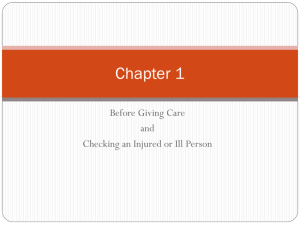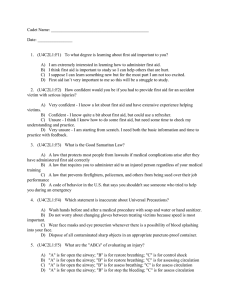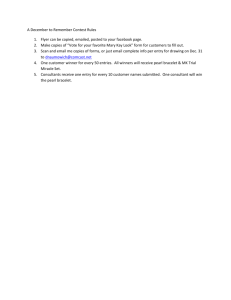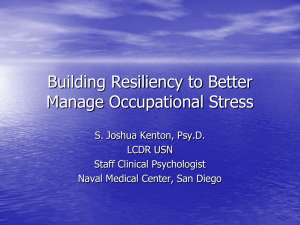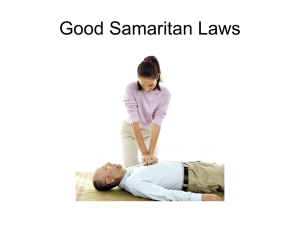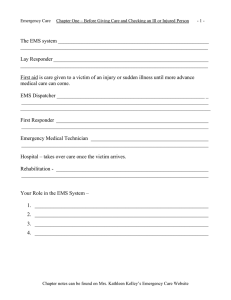First Aid Kit - Fair Lawn Schools
advertisement
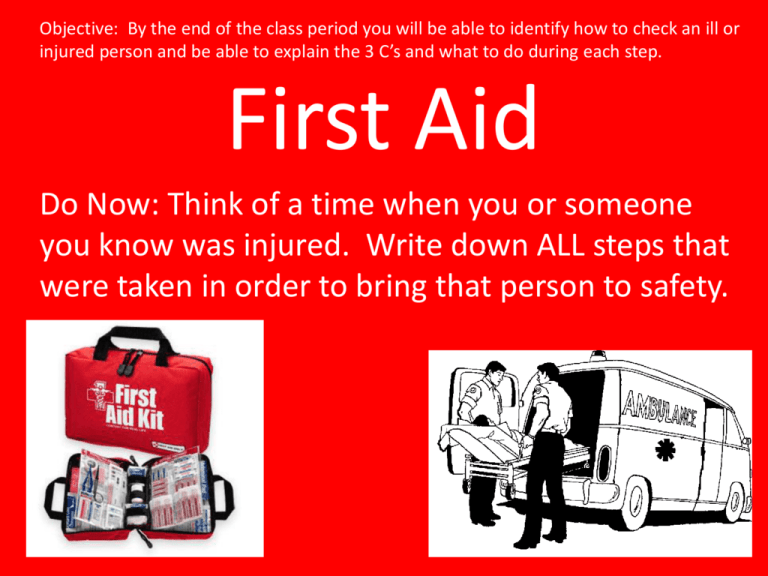
Objective: By the end of the class period you will be able to identify how to check an ill or injured person and be able to explain the 3 C’s and what to do during each step. First Aid Do Now: Think of a time when you or someone you know was injured. Write down ALL steps that were taken in order to bring that person to safety. Do Now: 1. Create a definition for the term First Aid. 2. Name 5 items in a first aid kit. Objective: By the end of the class period you will be able to identify how to check an ill or injured person and be able to explain the 3 C’s and what to do during each step. First Aid: initial response to an ill or injured person. First Aid Kit •Gauze Pads/Bandages •Adhesive Tape •Scissors •Instant Ice pack •Hand Sanitizer •Peroxide/Alcohol •Gloves FIRST AID • Your Role in the EMS System 1. 2. 3. 4. Recognize that an emergency exists. Decide to act. Activate the EMS system. Give care until help takes over. 1. Recognize that an Emergency Exists • Unusual Noises – Screaming, yelling, or calls for help – Breaking glass, crashing metal or screeching tires • Unusual sights – A stopped vehicle on the road, downed electrical wires, sparks or smoke • Unusual odors – Gas, fire, or odors that are unrecognizable • Unusual appearances or behaviors – Unconsciousness, confusion, trouble breathing, sudden collapse, clutching the chest or throat. 2. Decide to Act • • • • Panic or Fear of doing something wrong Assuming Someone else will take action Fear of catching a disease Fear of Being Sued: Good Samaritan Law 3. Activate EMS System • Call 9-1-1: most important step you can take in an emergency 4. Give care until help takes over. • Give appropriate care to an ill or injured person until: – You see an obvious sign of life, such as breathing – Another trained responder or EMS personnel take over – You are too exhausted to continue – The scene becomes unsafe Good Samaritan Law • Read the short article on page 4 of the textbook entitled “Fear of Being Sued: Good Samaritan Law.” • Answer the following questions after reading: – What is the Good Samaritan Law? – What would a reasonable and prudent person do? – When would this law NOT protect a lay responder? Objective: By the end of the class period you will be able to identify how to check an ill or injured person and be able to explain the 3 C’s and what to do during each step. Do Now: What is the Good Samaritan Law? Emergency Action Principles: CHECK, CALL, CARE CHECK • Check the scene and the victims. • Check for consciousness • Questions to be answered: – – – – Is the scene safe? What happened? How many victims are there? Can bystanders help? • Medical Alert Bracelet Medical Alert Bracelet • Used to identify people with certain medical conditions such as: – – – – Diabetes Internal Pacemaker Epilepsy Severe Allergies Learn More About Medical Alert Bracelets Call • If you have decided that the situation is an EMERGENCY situation, call 9-1-1. • If there is another person that is helping you, have them make the call. • Let them know the emergency, how many victims and their physical/mental state. CARE • Prior to giving care you must get consent from the victim by: – – – – – State your name Tell the victim you are trained in first aid Ask if you can help Tell them what you think is wrong Tell them how you plan on helping them • Once 9-1-1 is called care for the victim who is in the worst state – For example care for someone that is unconscious and not breathing rather than a person that has a cut or bruise Implied Consent • Permission to perform first aid care on an unresponsive victim (unconscious/not breathing) is assumed. • This is based on the idea that a reasonable person would give their permission to receive lifesaving first aid if they were able. Do Now: WRITE IN YOUR PLANNER THAT WE WILL BE HAVING A QUIZ ON: 4A- 10/27 6A-10/23 4B- 10/28 6B-10/22 Do Now: What is a medical alert bracelet? Name 2 medical conditions where a person may wear this bracelet. (Try to answer these questions without your notes)
